A Trio of Thermaltake Towers
by Joshua Buss on August 16, 2006 2:30 AM EST- Posted in
- Cases/Cooling/PSUs
Thermaltake Eclipse DV - External
The original Eclipse was a great case. It offered much of what's needed in a desktop tower enclosure and had few faults. Let's get right to it - the only significant change in this DV variation is the change from a mere CD holder primarily for decoration in the front to a full-fledged, fully functional, DVD/CD-R/W slim-line combo drive.
Because of this change, the front bezel can no longer really 'unfold' into two doors like the Eclipse did; instead the entire front bezel swings open to reveal the external bays and power / reset buttons. On the side is also where you'll find the button for opening the drive, just like laptop drives. In this shot you can also see the nicely folded cables for the drive and lights, ensuring one will never have to worry about the cables getting stuck or kinked when opening the door.
Taking a step back, here's a more direct shot of the front bezel. The clear plastic strips in the middle of the front light up blue when the computer is powered on, and HDD activity is signaled by a red LED adding to the light show on the left side of the bottom strip. A disc in the drive is quite visible through the sharp looking window, not unlike many popular table-top CD players available.
The ornament at the bottom is supposed to indicate volume based on a soundcard's output levels, but in our experience it seemed to respond directly to access of the disc in the included drive, as it was glowing even with our on-board sound card disabled in our test bed.
Now we'll examine that right side in a little more detail. The lock and front ports are here, closer to the bottom, so along with the drive opening in this direction here are two more reasons to make sure there is plenty of clearance on the right side of the case towards the front.
The Eclipse DV suffers from a problem found in many other cases unfortunately, and that is the problem of requiring a certain amount of clearance on both sides of the case for optimum usability / appearance. On the one hand, the ports, the optical drive, and the main front door are all accessed from this side, but enjoying the view the case window provides and doing anything internal requires relatively unrestricted access from the left side. The good news though is that there is no need for completely unrestricted access to the right side - only the front area needs to be open.
Here is one of the nicest features of the Eclipse DV: unlike cases which require the front bezel to be forcefully pried off, this Thermaltake case has been designed to make this process a cinch.
Unlocking the latch with the provided key allows this entire portion of the case to hinge out, providing easy access to the external drive bays and their respective covers, as well as the removable filter for the front 120mm fan. Again, cable management has been thought through carefully, and the latching fit itself is snug and secure.
The original Eclipse was a great case. It offered much of what's needed in a desktop tower enclosure and had few faults. Let's get right to it - the only significant change in this DV variation is the change from a mere CD holder primarily for decoration in the front to a full-fledged, fully functional, DVD/CD-R/W slim-line combo drive.
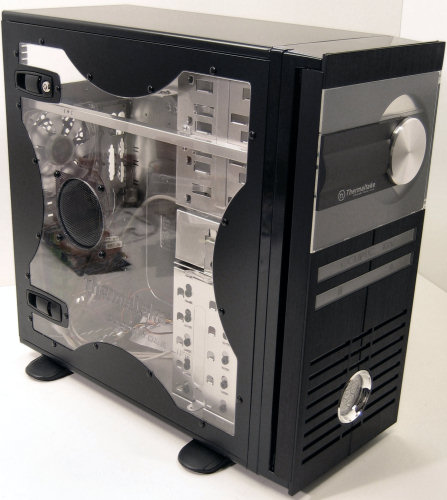 |
| Click to enlarge |
Because of this change, the front bezel can no longer really 'unfold' into two doors like the Eclipse did; instead the entire front bezel swings open to reveal the external bays and power / reset buttons. On the side is also where you'll find the button for opening the drive, just like laptop drives. In this shot you can also see the nicely folded cables for the drive and lights, ensuring one will never have to worry about the cables getting stuck or kinked when opening the door.
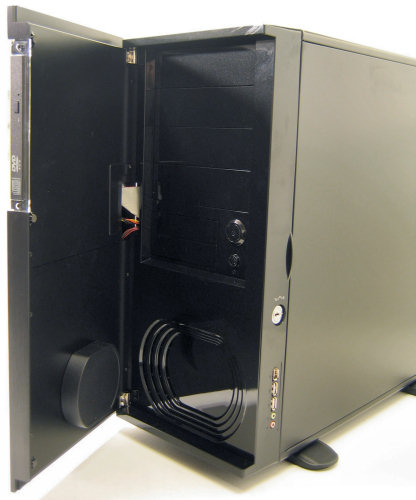 |
| Click to enlarge |
Taking a step back, here's a more direct shot of the front bezel. The clear plastic strips in the middle of the front light up blue when the computer is powered on, and HDD activity is signaled by a red LED adding to the light show on the left side of the bottom strip. A disc in the drive is quite visible through the sharp looking window, not unlike many popular table-top CD players available.
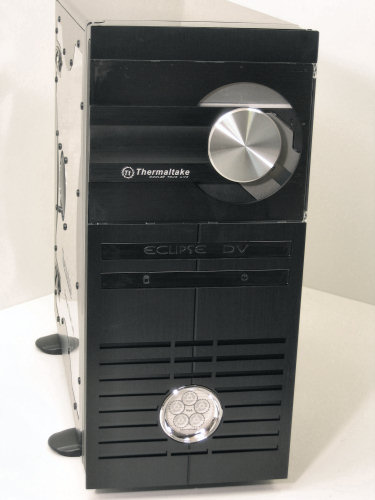 |
| Click to enlarge |
The ornament at the bottom is supposed to indicate volume based on a soundcard's output levels, but in our experience it seemed to respond directly to access of the disc in the included drive, as it was glowing even with our on-board sound card disabled in our test bed.
Now we'll examine that right side in a little more detail. The lock and front ports are here, closer to the bottom, so along with the drive opening in this direction here are two more reasons to make sure there is plenty of clearance on the right side of the case towards the front.
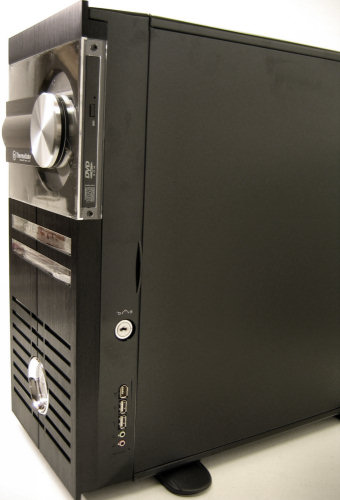 |
| Click to enlarge |
The Eclipse DV suffers from a problem found in many other cases unfortunately, and that is the problem of requiring a certain amount of clearance on both sides of the case for optimum usability / appearance. On the one hand, the ports, the optical drive, and the main front door are all accessed from this side, but enjoying the view the case window provides and doing anything internal requires relatively unrestricted access from the left side. The good news though is that there is no need for completely unrestricted access to the right side - only the front area needs to be open.
Here is one of the nicest features of the Eclipse DV: unlike cases which require the front bezel to be forcefully pried off, this Thermaltake case has been designed to make this process a cinch.
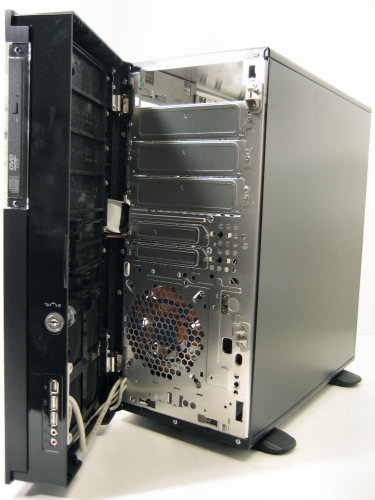 |
| Click to enlarge |
Unlocking the latch with the provided key allows this entire portion of the case to hinge out, providing easy access to the external drive bays and their respective covers, as well as the removable filter for the front 120mm fan. Again, cable management has been thought through carefully, and the latching fit itself is snug and secure.










43 Comments
View All Comments
Griswold - Thursday, August 17, 2006 - link
The first one looks like some vertical hi-fi deck with a side window - and I hate side windows.Yuck indeed.
seven9sn10s - Thursday, August 17, 2006 - link
The Aguila has a measurement of 27dB(12" above) and subjective rating of 2/10.In a previous review, the Raidmax X1 & Antec P150 both a measurement of 45dB(12" above) & subjective rating of 2/10 & 2.5/10 respectively. The subject ratings to dB measurements do not seem to be on a consistent scale. Am I to believe that the Aguila is so much quieter than the Raidmax X1 or Antec P150?? Please clear this up. Thanks.
seven9sn10s - Friday, August 18, 2006 - link
Hello???Somebody please answer.. is this Aguila case far quieter than the Antec P150/Solo? Tryin to build a system here. Thanks.
poopoohead - Sunday, August 20, 2006 - link
yeah, me too! the measurement seems so low compared to any other case they have ever tested, even the Zalman HTPC that they said was very quiet? why does the article not make special mention of the aguila super quietness?Gholam - Thursday, August 17, 2006 - link
HEC 6A rebadge, Chieftec DX rebadge... pay once for the case, and twice more for a TT sticker. No thanks.Missing Ghost - Wednesday, August 16, 2006 - link
The Aguila with no window does not exist?! I thinkstthiel - Wednesday, August 16, 2006 - link
"There's a law on AnandTech case reviews: no matter what they might review, a bunch of people have to show up and grouse about how the cases look like crap, or they're nice looking but too expensive, or some other opinion followed by the statement that "no one would ever buy these...."So what your saying is people have different opinions...thats very insightful.
teng029 - Wednesday, August 16, 2006 - link
i like this case, although removable motherboard trays should be standard on cases these days.tthiel - Wednesday, August 16, 2006 - link
Those are some seriously ugly cases.eastvillager - Wednesday, August 16, 2006 - link
All bling, no zing.